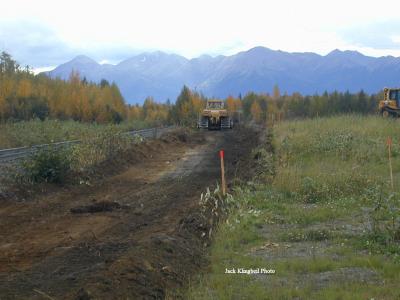Modern Railroad Building
What once took strong backs and stout spirits was replaced
by bulldozers, graders, compactors and side dump cars. Contemporary
railroad construction has truly become a ballet of man and machine.
The surveyor begins the process, marking the area where
the tracks will appear. Modern Global Positioning Systems (GPS) are
used to obtain pin point accuracy.
 Next,
the land is often cleared of larger trees using hydraulic "feller bunchers"
or similar specialized equipment. Brushcutters are used to slash
the smaller ones. Excavators and front loaders are used to remove
overburden. Dump trucks, dozers
and scrapers make rough grade.
Next,
the land is often cleared of larger trees using hydraulic "feller bunchers"
or similar specialized equipment. Brushcutters are used to slash
the smaller ones. Excavators and front loaders are used to remove
overburden. Dump trucks, dozers
and scrapers make rough grade.
Various types of compacting equipment is utilized to compact
the fill section. 8 1/2' track ties are placed 19" OC using cranes
and tie handlers. The ties can be purchased with plates already affixed.
115# rail in 39' or 80' lengths (or longer for continuously
welded rail-CWR) is placed by crane. Hydraulic or gasoline powered
tools are used to saw and drill rail. Bolt machines are used to tighten
the joint (angle) bar bolts. Spikes are machine driven.
Rail anchors (to resist longitudinal rail movement) are machine applied.
Sometimes track is laid in pre-made panels, 39' typically. After
the panels are laid one rail is pulled lengthwise to provide the requisite
stagger (so you get your "clickety clack").
A work train dumps ballast onto the "skeleton" track using hopper
or dump cars. Ballast
regulators perform precision ballast dressing and final brooming of the
track. Tamper/liners raise
the skeleton track onto the ballast while vibrating the ballast into the voids
under the ties. The track is lined both vertically and horizontally by
these machines.
Track guys are always wanting to raise track to improve
it. They want more or better ballast under the ties to improve drainage
or resistance to undesirable track movement (sun kinks, settling, etc).
This can create quite a problem for the bridge building guys. Bridges
shouldn't be raised unless absolutely necessary. For example, the 700'
main span across the Tanana River at Nenana (The
Mears Bridge) would be tough to raise. Anyway, a machine called
an "Undercutter" can be used to remove/replace or even recycle poor quality
(dirty) ballast from under the ties without any resultant track raise.
See also:
 Next,
the land is often cleared of larger trees using hydraulic "feller bunchers"
or similar specialized equipment. Brushcutters are used to slash
the smaller ones. Excavators and front loaders are used to remove
overburden. Dump trucks, dozers
and scrapers make rough grade.
Next,
the land is often cleared of larger trees using hydraulic "feller bunchers"
or similar specialized equipment. Brushcutters are used to slash
the smaller ones. Excavators and front loaders are used to remove
overburden. Dump trucks, dozers
and scrapers make rough grade.